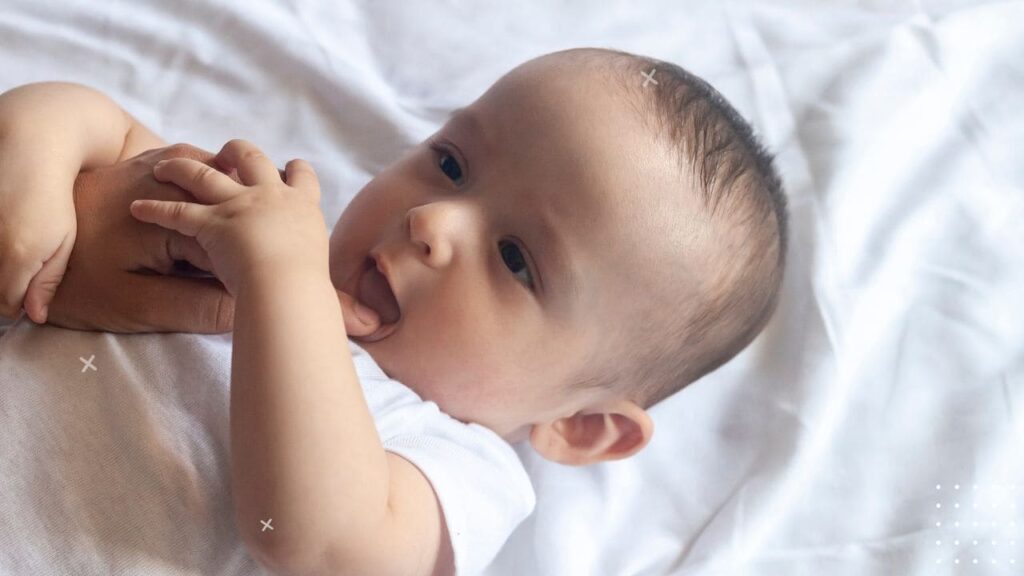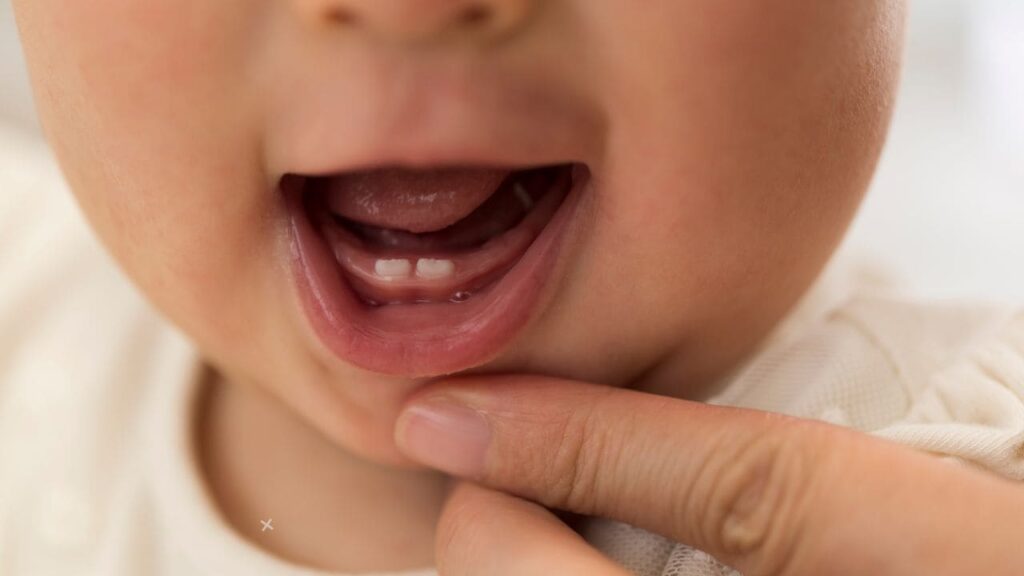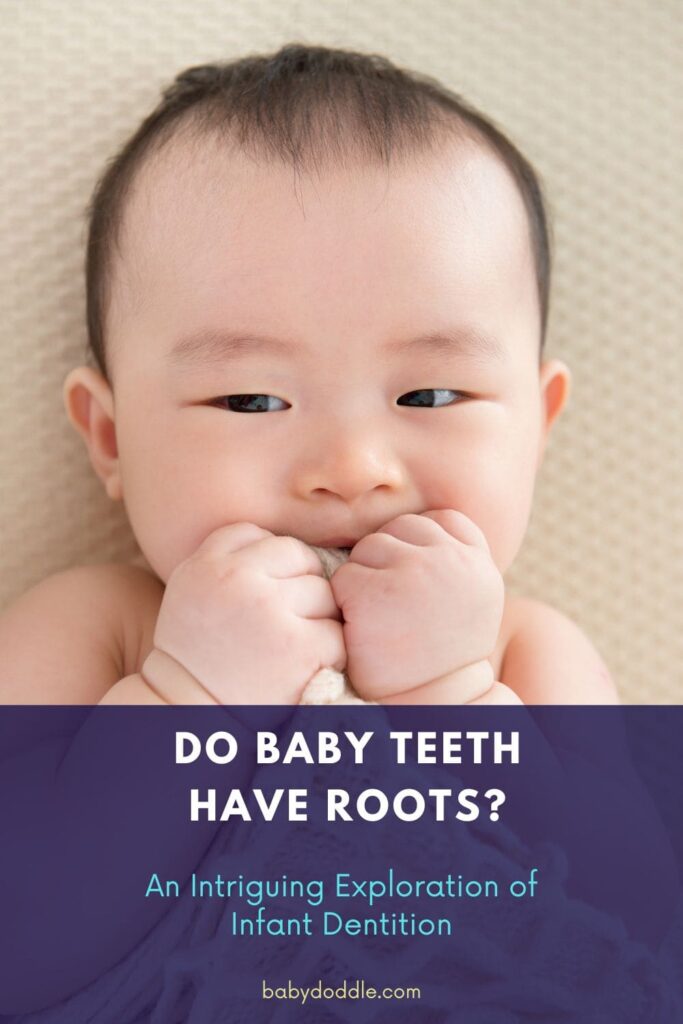Picture this: your little one flashes that heart-melting grin, and you find yourself captivated by those tiny pearly whites. Those adorable baby teeth are more than just a charming sight; they play a vital role in your child’s overall development. But have you ever wondered if those temporary teeth have roots and if so, what purpose they serve?
In this comprehensive blog post, we’ll embark on an intriguing exploration of infant dentition, delving deep into the mysteries surrounding baby teeth and their roots. Get ready to uncover fascinating facts, dispel common myths, and gain valuable insights into caring for your child’s oral health from the very beginning.

The Anatomy of Baby Teeth: Exploring Their Structure
To truly appreciate the importance of baby teeth roots, we must first understand the intricate anatomy of these temporary teeth. Just like their permanent counterparts, baby teeth are composed of several layers, each serving a unique purpose.
The outermost layer, known as the enamel, is the hardest substance in the human body. This protective coating shields the tooth from daily wear and tear, ensuring its longevity until it’s time for it to be replaced by a permanent tooth.
Beneath the enamel lies the dentin, a porous layer that supports the enamel and provides a degree of cushioning for the tooth. At the center of each baby tooth is the pulp chamber, housing the delicate nerves and blood vessels that keep the tooth alive and thriving.
But what about the roots? Yes, baby teeth do indeed have roots, and they play a crucial role in the overall structure and function of these temporary teeth.
What Does a Baby Tooth Root Look Like?
Baby tooth roots may appear smaller and simpler compared to their permanent counterparts, but they are no less fascinating. Unlike permanent teeth, which can have multiple roots, baby teeth typically have a single root that anchors them firmly into the jawbone.
The root structure of baby teeth can vary depending on the type of tooth. For instance, the roots of incisors (front teeth) tend to be slender and conical, while those of molars (back teeth) are generally broader and more flared.
What is the Function of a Tooth Root?
The primary function of a tooth root is to provide a sturdy foundation for the tooth, anchoring it securely into the jawbone. However, roots serve more purposes than just physical support.
Within the root canal lies a network of nerves and blood vessels, responsible for nourishing the tooth and transmitting sensory information to the brain. This intricate system allows your child to experience sensations such as temperature changes or pressure when biting down.
Healthy roots are essential for maintaining the overall integrity and longevity of baby teeth. If the roots become damaged or infected, it can lead to a variety of issues, including tooth pain, swelling, and even premature tooth loss.
The Difference Between Adult and Baby Teeth Roots
While both baby and adult teeth have roots, there are some notable differences between the two. Adult teeth, or permanent teeth, typically have longer, more complex root structures that extend deeper into the jawbone.
Additionally, permanent teeth often have multiple roots, which can vary in number and shape depending on the type of tooth. For instance, molars can have two or three roots, while incisors and canines generally have a single root.
The intricate root canal system of adult teeth is also more developed and branched, reflecting the increased complexity of these permanent structures.
In contrast, baby teeth roots are generally shorter, simpler, and less extensive, reflecting their temporary nature.

The Growth and Shedding Process of Baby Teeth
As fascinating as the anatomy of baby teeth is, their life cycle is equally intriguing. From the moment they emerge through the gums to the eventual shedding process, baby teeth undergo a remarkable journey.
The eruption of baby teeth typically begins around the age of 6 months, with the lower central incisors being the first to make their debut. Over the next few years, the remaining baby teeth will gradually emerge, following a specific pattern and timeline.
While the order of eruption can vary slightly from child to child, the general sequence is as follows: lower central incisors, upper central incisors, upper lateral incisors, lower lateral incisors, first molars, canines, and finally, second molars.
Around the age of 5 or 6, the shedding process begins, as the roots of the baby teeth start to resorb, or dissolve, making way for the permanent teeth to emerge.
What Happens to Your Baby Teeth Roots?
As the permanent teeth begin to develop and push upwards, a fascinating process known as root resorption takes place. This natural phenomenon involves the gradual breakdown and dissolution of the baby tooth roots, facilitated by specialized cells called odontoclasts.
During root resorption, the body releases enzymes that break down the root structure, allowing the permanent tooth to emerge without obstruction. Additionally, the tissues surrounding the baby tooth roots also play a role in this intricate process, helping to guide the new permanent tooth into its proper position.
The presence of calcium hydroxide, a byproduct of the resorption process, further aids in creating a favorable environment for the permanent tooth to erupt smoothly.
While root resorption is a natural and necessary process, it’s essential to monitor your child’s dental development closely. In some cases, issues such as hypodontia (missing permanent teeth) or other developmental anomalies can impact the shedding process, potentially requiring intervention from a dental professional.
Why Roots Are Important for Baby Teeth
Now that we understand the anatomy and growth cycle of baby teeth, let’s explore why their roots are so crucial for your child’s overall oral health and development.
One of the primary roles of baby teeth roots is to provide a stable foundation for the teeth, allowing your child to chew and bite down effectively. Without strong roots, the teeth would become loose and unstable, making it difficult for your child to properly break down food and develop proper chewing habits.
Furthermore, baby teeth roots play a vital role in guiding the eruption and positioning of the permanent teeth. As the roots resorb, they create a pathway for the permanent teeth to emerge in their proper alignment. Any disruption or irregularity in this process can lead to issues such as crowding, misalignment, or impaction of the permanent teeth.
Healthy baby teeth roots also contribute to the overall development of the jawbone and facial muscles. As your child chews and bites down, the roots stimulate the jawbone, promoting healthy growth and development. This, in turn, helps to ensure proper facial structure and alignment as your child grows.
Caring for Baby Teeth: Tips and Best Practices
While baby teeth are temporary, their importance cannot be overstated. Maintaining healthy baby teeth and gums is crucial for your child’s overall well-being and sets the stage for a lifetime of good oral health habits.
Here are some essential tips and best practices for caring for your little one’s baby teeth:
- Start oral hygiene routines early: Even before the first tooth erupts, gently wipe your baby’s gums with a clean, damp cloth after feedings. This helps remove bacteria and accustoms your child to the sensation of cleaning their mouth.
- Brush twice daily: Once those baby teeth start appearing, begin brushing them twice a day with a soft-bristled toothbrush and a rice-sized smear of fluoride toothpaste. Proper brushing technique is essential to remove plaque and prevent tooth decay.
- Introduce flossing: As soon as two teeth touch, it’s time to start flossing. Gently flossing between baby teeth helps remove food particles and bacteria that can lead to cavities.
- Limit sugary snacks and drinks: Sticky, sugary foods and beverages can cling to teeth, promoting tooth decay. Opt for healthy snacks like fresh fruits and vegetables, and encourage your child to drink water or milk.
- Schedule regular dental visits: Start taking your child to the dentist by their first birthday or within six months of the first tooth erupting. Regular check-ups allow the dentist to monitor your child’s dental development and catch any potential issues early.
| Age | Routine |
| Before teeth emerge | Wipe gums with a clean, damp cloth after feedings |
| First tooth eruption | Brush twice daily with a soft-bristled toothbrush and a rice-sized smear of fluoride toothpaste |
| Two teeth touching | Begin flossing between teeth |
| 2 years and older | Use a pea-sized amount of fluoride toothpaste for brushing |
| Regular dental visits | Start by the first birthday or within 6 months of the first tooth erupting |
What if the Root of a Baby Tooth That Fell Out is Still In?
It’s not uncommon for a baby tooth root to remain in the gum after the crown (visible part of the tooth) has fallen out. While this may seem concerning, it’s generally not an emergency situation.
In most cases, the remaining root will eventually work its way out on its own or be resorbed by the body. However, it’s essential to monitor the area for any signs of discomfort, swelling, or infection.
If your child experiences persistent pain or discomfort, or if the area appears inflamed, it’s best to consult with a pediatric dentist. They may recommend removing the remaining root to prevent any potential complications.
Common Issues and Concerns Related to Baby Teeth Roots
While baby teeth are designed to eventually fall out and make way for permanent teeth, there are certain issues and concerns that can arise related to their roots. Being aware of these potential problems can help you take proactive measures to maintain your child’s oral health.
One of the most common concerns is tooth decay, which can affect both the crowns and roots of baby teeth. When bacteria and food particles accumulate around the teeth, they can produce acids that erode the enamel and dentin, leading to cavities. If left untreated, decay can reach the root and cause infections or abscesses.
Another issue that may arise is a dental injury, such as a cracked or chipped tooth. If the damage extends to the root, it can compromise the tooth’s structure and potentially lead to further complications like infections or premature tooth loss.
In some cases, the root of a baby tooth may become infected or inflamed, a condition known as pulpitis. This can be caused by various factors, including deep cavities, trauma, or developmental abnormalities. Root infections can be painful and may require treatment, such as a pulpotomy (partial root canal) or extraction, to prevent further complications.
It’s essential to be vigilant about any signs of discomfort, swelling, or changes in your child’s eating habits, as these could indicate an underlying issue with the roots of their baby teeth. If you notice any concerning symptoms, don’t hesitate to consult your pediatric dentist for proper evaluation and treatment.
| Sign | Potential Issue |
| Persistent toothache or pain | Tooth decay, root infection, trauma |
| Swelling or redness around the gum line | Abscess, gum disease |
| Difficulty chewing or eating | Tooth sensitivity, loose tooth |
| Discoloration or dark spots on the tooth | Decay, trauma |
| Foul odor or taste | Infection, abscess |

The Transition to Permanent Teeth: What to Expect
As your child grows, the transition from baby teeth to permanent teeth is an exciting milestone. However, this process can also bring its own set of challenges and concerns. Understanding what to expect during this phase can help you better support your child’s oral health.
The transition to permanent teeth typically begins around the age of 6, with the first permanent molars erupting behind the baby teeth. Over the next several years, the remaining baby teeth will gradually be replaced by their permanent counterparts, following a specific pattern and timeline.
It’s important to note that the timing of this transition can vary from child to child, and some may experience delayed or accelerated tooth eruption. Factors such as genetics, nutrition, and overall health can influence the pace of this process.
During the transition phase, it’s common for children to experience a temporary misalignment or crowding of teeth. This is because the permanent teeth are often larger than their predecessors, and the jaw may need time to accommodate the new tooth sizes and positions.
Additionally, some children may experience issues such as impacted teeth (teeth that fail to erupt properly) or supernumerary teeth (extra teeth that develop). These conditions may require intervention from an orthodontist or oral surgeon to ensure proper alignment and prevent future complications.
Maintaining good oral hygiene habits is crucial during this transition period. Regular brushing, flossing, and dental check-ups can help prevent cavities, gum disease, and other issues that can potentially affect the permanent teeth as they emerge.
Conclusion
As you’ve discovered through this in-depth exploration, baby teeth and their roots are far more fascinating and crucial than they may initially seem. From providing a stable foundation for proper chewing and speech development to guiding the eruption and positioning of permanent teeth, these temporary structures play an instrumental role in your child’s overall oral health and well-being.
By understanding the anatomy, growth process, and importance of baby teeth roots, you can better navigate the various stages of your child’s dental development and take proactive measures to ensure a lifetime of healthy smiles.
Remember, establishing good oral hygiene habits from an early age and seeking regular dental check-ups are key to maintaining healthy baby teeth and promoting a smooth transition to permanent teeth.
If you ever have any concerns or questions about your child’s dental development, don’t hesitate to consult a trusted pediatric dentist. Their expertise and guidance can help address any issues promptly and ensure your little one’s dental journey is as smooth and comfortable as possible.
Embrace the intriguing world of infant dentition, and cherish those precious baby teeth as they pave the way for a lifetime of healthy, radiant smiles.
FAQ – Do Baby Teeth Have Roots
Throughout our exploration of baby teeth roots, you may have encountered some lingering questions or concerns. To provide you with a comprehensive understanding, let’s address some of the most frequently asked questions:
Can root resorption cause problems for permanent teeth?
While root resorption is a natural process, in rare cases, it can occur prematurely or excessively, potentially affecting the development and positioning of permanent teeth. If you notice any signs of delayed tooth eruption or abnormal spacing, consult your dentist for an evaluation.
Is tooth sensitivity in baby teeth a cause for concern?
It’s not uncommon for children to experience some tooth sensitivity, especially when consuming hot or cold foods and beverages. However, if the sensitivity persists or is accompanied by other symptoms like pain or swelling, it could indicate an underlying issue with the tooth roots or pulp. Seeking professional dental advice is recommended in such cases.
Can baby teeth roots impact the development of permanent teeth?
Yes, the health and positioning of baby teeth roots can influence the development and alignment of permanent teeth. If a baby tooth root is damaged or fails to resorb properly, it can obstruct the path for the permanent tooth, potentially causing it to erupt in an improper position or become impacted.
Is it necessary to treat cavities in baby teeth if they are going to fall out anyway?
While baby teeth are temporary, neglecting cavities or other dental issues can have long-lasting consequences. Untreated cavities can lead to pain, infections, and even premature tooth loss, which can affect the proper spacing and alignment of permanent teeth. Additionally, poor oral health in childhood can contribute to future dental problems, making it essential to address any issues promptly.
Is it normal for my child’s baby tooth to bleed after it falls out?
It’s perfectly normal for some bleeding to occur when a baby tooth falls out or is wiggled loose. The root of the tooth is anchored to the jawbone through a network of blood vessels and tissues. When the tooth is dislodged, these connections are severed, causing minor bleeding.
However, if the bleeding is excessive or persists for more than an hour after the tooth has been removed, it’s essential to seek professional dental advice. Excessive bleeding could be a sign of an underlying issue, such as an infection or a blood clotting disorder.
Here are some tips to manage bleeding after a baby tooth falls out:
- Apply gentle pressure: Have your child bite down on a clean, moist gauze or a clean cloth for about 15-20 minutes. The pressure will help form a blood clot and stop the bleeding.
- Avoid rinsing or spitting: Rinsing or spitting can dislodge the forming clot and prolong the bleeding. Encourage your child to swallow any blood that accumulates in their mouth.
- Use cold compresses: Applying a cold compress or an ice pack wrapped in a thin cloth to the outside of the cheek can help constrict the blood vessels and reduce swelling.
- Provide pain relief: If your child experiences discomfort or pain, you can give them an age-appropriate dose of over-the-counter pain medication, such as acetaminophen or ibuprofen.
- Monitor for complications: If the bleeding doesn’t stop after an hour, or if your child experiences severe pain, swelling, or fever, it’s crucial to contact your pediatric dentist immediately.
Remember, losing baby teeth is a natural process, and some bleeding is expected. However, if you have any concerns or the bleeding seems excessive, don’t hesitate to seek professional advice to ensure your child’s comfort and safety












